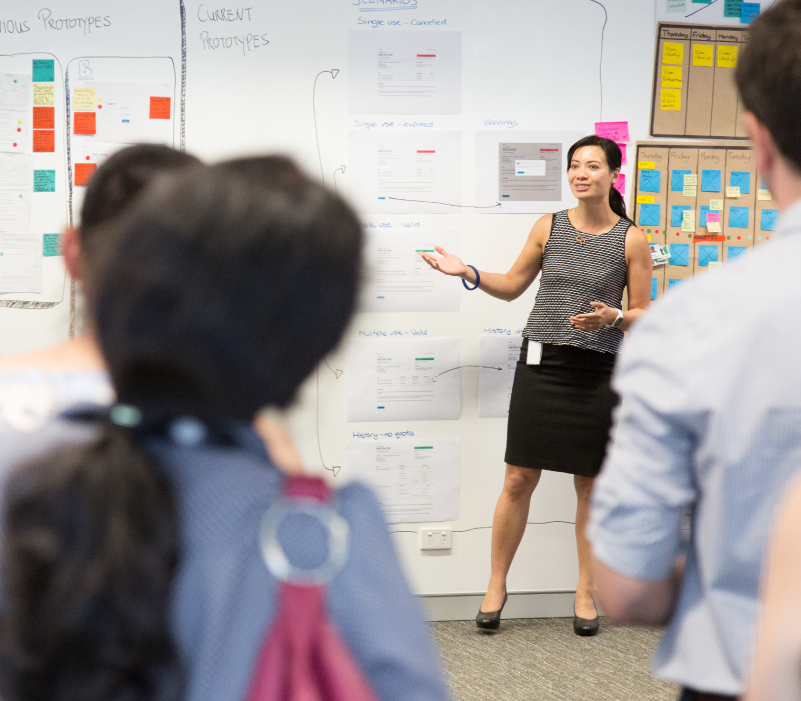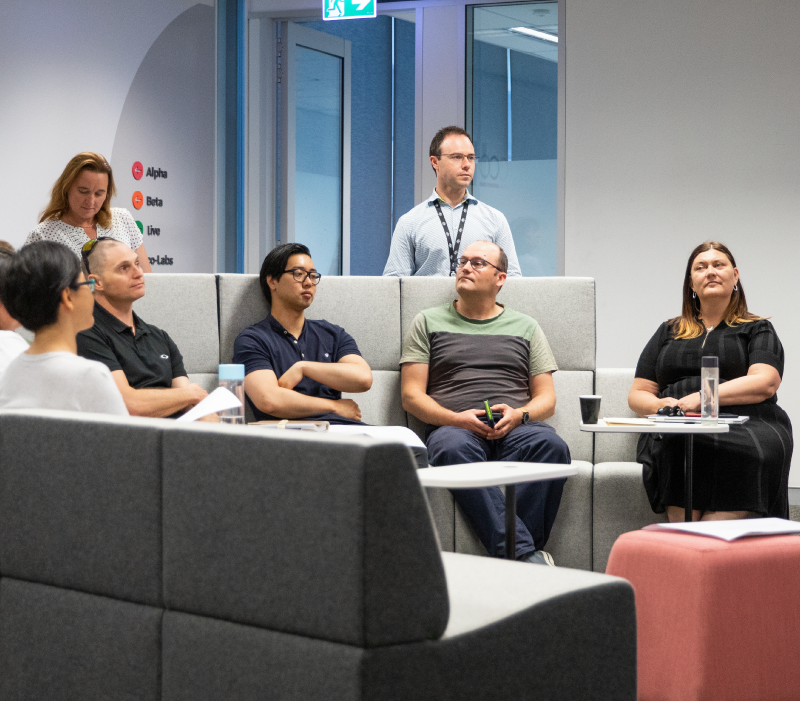-
Report progress during Investment Oversight Framework states and post-implementation performance data
Reporting using existing reporting mechanisms will make sure your proposal or project is complying with the Performance Standard. This will occur as part of the DTA’s Digital and ICT Investment Oversight Framework process. Depending on your ICT investment your agency will be requested to report information in the following states:
- Strategic Planning and Prioritisation: within your proposal or business case report on how you intend to implement a monitoring framework to your digital service.
- Contestability: report that the Performance Standard has been, or will be, applied to the digital service. For example, as part of the Digital Capability Assessment Process
- Assurance: report how you have applied the Performance Standard to the digital service and made progress with delivery milestones.
- Operations: using the DTA’s existing data collection mechanisms such as the Approved Programs Collection, report on how your digital service continues to meet customer needs post-implementation.
-
Analyse performance results and make improvements to the digital service
- Apply the steps outlined in Develop processes for continuous improvement, which emphasises an agile approach to continuous improvement based on performance analysis.
-
Links
- Choosing digital analytics tools - Service Manual - GOV.UK (www.gov.uk)
- Whole-of-Government Application Analytics (WOGAA) - Improve Government Services with Data | Singapore Government Developer Portal (tech.gov.sg)
- Agile approach to service delivery | Digital NSW
- Understanding more from user feedback – Data in government (blog.gov.uk)
- DSS criterion 8. Innovate with purpose | digital.gov.au
- DSS criterion 10. Keep it relevant | digital.gov.au
-
-
-
-
Develop a business case for change
- Be outcomes focused: Consider what problems the service needs to solve and why they are important. Share early-stage assumptions, gather diverse perspectives from stakeholders and take advantage of pre-existing data and resources. Clearly state the risks of action and inaction, who might be impacted, potential barriers to success and any knowledge gaps.
- Frame the problem: Form a simple, clear problem statement from the evidence that’s already available. Use it as the basis of further research and validation, and to identify the users agencies need to engage with.
- Don’t jump to solutions: Don’t anticipate a technical or design solution before validating the problems identified. Evaluate the rest of the Digital Service Standard criteria to understand what else could drive the problem. Consider if a new solution is required or if an existing platform or service might achieve the best outcome.
- Align stakeholders to a vision: Engage key stakeholders to establish a shared vision for success. Set clear expectations for the project and make sure everyone knows why change is necessary.
-
Survey the policy and service landscape
- See the bigger picture: Assess how the problems identified play out in the broader policy and government service ecosystems. Use resources such as the Australian Government Architecture and Delivering Great Policy Toolkit to understand the landscape and the intentions of different policies.
- Align to government priorities: Have a clear understanding of how the service will contribute to government priorities, including the achievement of the Data and Digital Government Strategy 2030 vision.
-
Understand the service’s lifecycle
- Invest for the future: Consider whole-of-life investment costs, including maintenance and upgrades, to ensure proper investment across short, medium and long-term horizons. Make sure the team are familiar with the Investment Oversight Framework and its thresholds. Get in touch with the Digital Transformation Agency for questions about the ICT Investment Approval Process and work with the relevant area of the Department of Finance to understand ongoing costs.
-
Adopt an agile methodology
- Use a multi-disciplinary team: Consider tools and techniques based on agile values and principles. Engage a multidisciplinary team to understand the whole problem and create an effective solution. Monitor time and effort expended to understand and refine whole-of-life investment costs from the outset.
-
-
-
Guidance to have a clear intent
-
Understand the problems your service will solve
Understand your current digital landscape and the problems or gaps your service will solve:
- Conduct needs assessments and collect qualitative and quantitative data through surveys, interviews and focus groups to understand user experiences and challenges.
- Clarify the problem that needs to be addressed by creating user journey maps to visualise the user experience. Include pain points, problems that slow or halt progress and areas of confusion.
- Gather insights into challenges by engaging with a diverse range of stakeholders, including users, staff and community organisations.
- Periodically review and analyse trends in user behaviour and service performance to identify recurring problems and new challenges.
-
Understand government initiatives that address the problem
Research and identify existing programs or initiatives that address the problem. Leverage these initiatives to enhance service delivery or fill the gaps. Use methods or tools such as:
- Review government policies and existing initiatives and map the problem to relevant strategic objectives and priorities.
- Collaborate with other government agencies and departments with similar issues to facilitate resource sharing, knowledge exchange and coordinate efforts.
- Engage with stakeholders involved in related government initiatives to gain insights into government approaches and successes.
- Periodically review and update strategic objectives, ensure plans are flexible in response to new information, the changing landscape and user needs.
-
Document your findings
Document your findings and recommendations to apply criterion 1:
- Develop clear problem statements that articulate the issues identified. This will communicate the problem to stakeholders and set a focused direction for efforts.
- Make sure the data is collected and documented in a centralised knowledge repository.
-
The supporting standards
-
Links
- Customer journey mapping | For government | Queensland Government
- Current state journey map | vic.gov.au (www.vic.gov.au)
- Getting stakeholder engagement right | Australian Public Service Commission (apsc.gov.au)
- Module 4 Stakeholder Engagement | Digital NSW
- Stakeholder engagement | vic.gov.au (www.vic.gov.au)
- Knowledge Management | Digital NSW
- Strategic landscape | For government | Queensland Government
- Collaboration | Digital NSW
- Department of Premier and Cabinet - Critical factors for successful collaboration (dpac.tas.gov.au)
- 10: Collaborating across and beyond the Victorian public sector - VPSC
- 2. Set evaluation objectives | evaluation.treasury.gov.au
- Australian Government Guide to Policy Impact Analysis (pmc.gov.au)
-
-
-
Understand the users of the service
- Listen carefully for implicit and explicit needs: During user research, discuss their daily lives and observe their real-world actions to contextualise their needs. Use a discussion guide to capture all aspects of their experience. While some needs or pain points will be stated explicitly, pay attention to small or superfluous details to recognise the implicit ones. Use at least 2 methods of user research to make sure what they say matches what they do. For example, open-ended interviews and observing users completing relevant tasks.
- Begin with pain points: Identify and address the most common pain points that the service should address. Prioritise them by most impactful; this isn’t necessarily the number of users affected. Adopt continuous improvement to address pain points that emerge after launch or upgrades.
- Observe usage patterns: Use various data sources to identify how often different users use the service. Stress test any solutions for pain points along task journeys and assess load-bearing capacity during peak periods.
- Map experiences: Use visual aids to make sure the breadth of user interactions are captured and that the team works from a shared understanding. Build, test and refine journey maps and job stories. This will help to understand the end-to-end user journeys and behind-the-scenes processes. It will also reduce unintentional duplication and support agencies to communicate findings.
-
Conduct user research
- Test any assumptions: Validate assumptions made in Criterion 1 (‘Have a clear intent’). Qualitative user research conducted directly with people who may be impacted by the service will provide agencies with either confirmation that they are on the right track, or that they are solving the wrong problem and need to adapt their approach.
- Gather different perspectives: Undertake ethical and inclusive user research to capture a breadth of needs and capabilities. Zoom out and consider how the digital service interacts with the agency’s wider methods of service delivery. It is helpful to zoom in and out of the problem space to observe the different perspectives and impacts of the service being designed, and to explore how the problem may manifest at macro and micro levels.
-
Test and validate designs
- Embed co-design: Where appropriate, use co-design to involve users and stakeholders and demonstrate transparent, equitable decision making. Avoid tokenism by meeting people’s physical, cultural and psychological safety needs in consultations. Maintain ongoing user engagement to keep the service fit for purpose and address changing needs over the course of people’s lives.
- Engage designers: Make sure the team has the expertise to capture and interpret useful information from users’ personal experiences. Use service designers and user experience (UX) designers to conduct user research, map experiences and design the service to meet and surpass the needs of all users.
-
-
-
Guidance to know your user
-
Understand who uses your service
Understand who uses your service and establish what their needs are. Use methods or tools such as:
- Regularly collect qualitative and quantitative data and user feedback from user research surveys, usability testing, interviews and focus groups.
- Use web analytics and user data to verify current users, including demographics, behaviours and usage patterns.
- Create user personas representing different segments of the user base to visualise the user and understand their needs.
-
Address pain points and negative feedback
Draw on feedback, data and insights to highlight the needs and challenges of users. Use methods or tools such as:
- Conduct a thorough analysis of any identified pain points or negative feedback to understand the root cause.
- Use an iterative design process, make incremental changes based on feedback and test these changes with users to assess their effectiveness.
- Prioritise pain points that have the most significant impact on user experience and ensure resources are allocated effectively.
-
Identify patterns and trends in usage
Identify usage patterns and trends to paint a picture of the users of the service. Use methods or tools such as:
- Use analytics to identify usage patterns, such as peak usage times, common user paths and drop-off points.
- Prioritise features that align with identified usage patterns and user needs to ensure that resources are focused on what users value most.
- Continuously monitor usage data after implementing changes and adjust strategies as necessary. This will make sure improvements meet user needs.
- Combine user research efforts across the DX Policy and its standards to reduce duplication and the cost of research.
Connect with the digital community
Share, build or learn digital experience and skills with training and events, and collaborate with peers across government.





